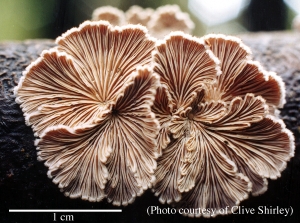
Schizophyllum commune has been the subject of genetic analysis since the early twentieth century, when Kniep first described its tetrapolar pattern of sexuality. It has been utilized as a model system for studying mating-type gene function and mushroom development. In addition, the biochemistry and enzymology of the cell walls of S. commune has been a long-term focus of research. It belongs to the group of gilled mushrooms that includes the commercially valuable species Agaricus bisporus (white button mushroom) and Pleurotus ostreatus (oyster mushroom). The worldwide market for these and other mushrooms for use as food, as dietary supplements and nutriceuticals, and in medicine was estimated to be over US $13 billion per year in 1995. Mushrooms from many of these fungi are also the source of important medicinal compounds with activities against tumors, viruses, and other microbes. S. commune is also now recognized as one of the important agents of sinusitis, and is one of the few filamentous basidiomycetes documented to colonize and cause severe infections in immunocompetent humans.
S. commune is a ubiquitous white rot fungus with a worldwide distribution that can degrade complex plant biomass, including lignin. In DOE's vision of the biorefinery, plant cell wall material is degraded into simple sugars, which are subsequently fermented into useful products such as organic acids. These compounds can be further converted by enzymes or catalysts into industrially useful chemicals. In order for S. commune or other white rot fungi to degrade complex biomass, a large repertoire of enzymes must be encoded by the organism, as evidenced by the data generated from the JGI Phanerochaete chrysosporium genome project. We expect that the genome of S. commune will yield an equally interesting catalog of secreted enzymes that play a role in ligno-cellulose degradation.
S. commune also shows promise for the bioremediation of uranium and rare earth elements. High concentrations of uranium and rare earth elements in mine seepage water were significantly reduced by incubation with S. commune. S. commune has also been shown to take up and concentrate cadmium from the environment. Taken together, these studies show that the bioremediation potential of S. commune has a strong connection to the DOE mission in environmental management. A genome sequence, combined with already established molecular techniques, would make S. commune an ideal model organism for additional studies in metal uptake by fungi.
Current research predicts that greenhouse gases will contribute to a 2-5°C increase in global mean temperatures over the next century. Carbon sequestration is proposed as a means of offsetting this occurrence. In systems that are actively accruing carbon during ecosystem restoration, as a group the fungi become an increasingly larger and more active component of the soil microbial biomass. Certain fungi have been demonstrated to both enhance carbon sequestration and to reduce carbon loss by minimizing the mineralization of soil organic carbon. Identifying the specific fungal species and their functions involved in soil carbon dynamics will be a key milestone in using fungi to enhance carbon sequestration in terrestrial systems. The sequencing and annotation of fungal genomes such as that of S. commune will make a significant contribution to that accomplishment.
Genome Reference(s)
Ohm RA, de Jong JF, Lugones LG, Aerts A, Kothe E, Stajich JE, de Vries RP, Record E, Levasseur A, Baker SE, Bartholomew KA, Coutinho PM, Erdmann S, Fowler TJ, Gathman AC, Lombard V, Henrissat B, Knabe N, Kües U, Lilly WW, Lindquist E, Lucas S, Magnuson JK, Piumi F, Raudaskoski M, Salamov A, Schmutz J, Schwarze FW, vanKuyk PA, Horton JS, Grigoriev IV, Wösten HA
Genome sequence of the model mushroom Schizophyllum commune.
Nat Biotechnol. 2010 Sep;28(9):957-63. doi: 10.1038/nbt.1643
